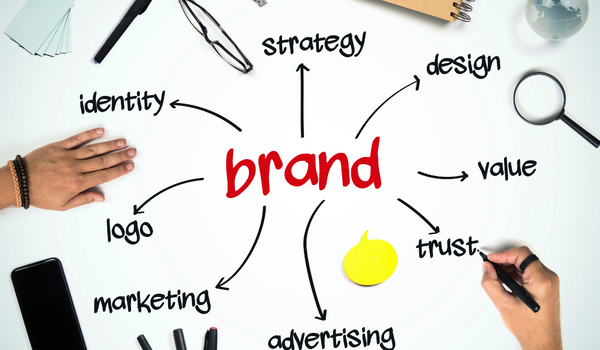You walk the Hero’s Path every day every time you dedicate time to your venture, they are firm steps that you take with certainty and some uncertainty, just like a hero: brave. Here we are going to tell you which are the Brand pillars that you must take into account to achieve a strong digital presence.
What is Brand Identity and how this path can help your company?
Your brand identity is the combination of various verbal and visual attributes that add value to your brand’s reputation. It is essentially your company’s or product’s version of “who we are, what we stand for, what we look like and how we communicate that to others.” This article will help you understand why brand identity is important to business success and explain how it can be used as a strategic tool.
We understand branding as both the set of identity signs that make up each brand and the process of creating them. Identity signs that can go from the visual identity, the logo, as it is usually called, to, for example, the sound identity (audiobranding), the brand personality, its tone of communication or, for example, each of the elements that make up that visual identity mentioned in the first place: the logotype (which in reality can also be isotype, isologotype, imagootype, monogram), the corporate typography (the typefaces used in written communication), the corporate colorimetry (the representative colors of each brand, in their specific tones), the corporate applications (whether digital or physical), etc.
All those signs that together form what we call the brand and which, as we can see, goes far (very far) beyond the “logo”. But before going into the subject of the composition of a brand, let us review its importance.
Learn more about branding and brand experience!
¿What is brand identity?
Brand identity is the identity of a company or product in the marketplace. It is the combination of visual and verbal attributes that create a brand and its reputation. It is essentially your company’s or product’s version of “who we are, what we stand for, what we look like and how we communicate that to others.” Brand identity includes the aspects and characteristics of a brand such as the logo, name, tagline and visual language. It can also include how the company interacts with customers, i.e. tone of voice, product experience and quality of service.

¿Why is brand identity important for companies?
Before we discuss how brand identity can help your business, let’s first talk about why it’s important. Brand identity is critical to business success because it gives potential customers a way to recognize and connect with your brand. It also gives your company a distinct identity that helps you stand out from your competitors and makes it easier to market your products and stay relevant over time. You can use brand identity as a strategic tool to market your products and services, gain consumer trust and increase revenue. The more effective your brand identity is and the more it aligns with your company’s objectives, the faster you can achieve success.
How to use brand identity for business success
Developing a strong brand identity is the first step to business success. To do so, you can follow these six steps:
-Define your brand – Understand your ideal customers’ needs and what they expect from your brand. What problems do they want your brand to solve? What is the core promise of your brand? – Research your competition – Research and analyze how your competitors’ brands are positioned in the marketplace. What makes them unique compared to your company’s brand? – Create a visual and verbal identity – Create a visual and verbal identity for your brand. This will consist of the logo, name, tagline and visual language. – Find the right marketing channels – Find the right channels to promote your brand identity and reach your target audience. Consider paid and organic marketing channels, such as social media marketing and content marketing, to help make your brand more recognizable. – Track and measure your progress – Track and measure your progress to ensure your brand identity is effective. Look at factors such as brand awareness, conversion rates and customer sentiment to track your progress and make any changes if necessary. – Deliver a consistent experience: make sure you deliver a consistent experience across all channels to reinforce your brand identity.
The importance of having a strong brand voice
Brand voice is the tone of voice your brand uses when engaging with customers through content marketing, such as blogs and social media posts. Having a consistent brand voice across all of your marketing channels can help you build trust and strengthen relationships with consumers. It can also help you attract leads and increase conversion rates. A strong brand voice can also make your brand feel more human and approachable, adding an element of personality to otherwise “cold and corporate” business practices. Having a strong brand voice can help you create a unique identity, persuade customers and remain competitive. You can create a brand voice by using the same tone of voice throughout your content, conducting brand voice audits to ensure your brand voice is consistent, and collaborating with your team.
How to build a brand identity?
Your brand identity has to represent your company and its values completely and you have to be constant when it comes to putting it into practice. In our marketing agency in Santiago de Compostela we are clear about the key elements to start building it:
The name of a brand (naming)
The brand name (naming) is one of the brand elements that most helps customers to identify and differentiate one product – or service – from another. It should be chosen with great care, as it is mandatory in this case to capture the key theme of a product, service or business in an efficient and narratively economical manner. A name whose meaning is self-understandable – that is, the name itself explains its origin (as well as that of the product, service or business it represents), that the user can easily remember and that triggers in his or her head the sensations we want to activate in the user’s mind.
Choosing a brand name requires a lot of research
Brands do not necessarily have to be associated with the product or service they identify. For example, trademarks can be based on places (Air India, British Airways…), on animals (Dove, Puma…), on people’s names (Pierre Cardin, Louis Vuitton…). In some cases, the company name is used for all products and services (as in the case of General Electric or LG).

Characteristics of a good brand name
A good brand name should have the following characteristics:
- It must be unique and distinctive.
- It must be extensible.
- It must be easy to pronounce, identify and memorize.
- It must give an idea about the qualities and benefits of the product.
- It must be easily convertible into foreign languages.
- It must be legally registrable.
- It must suggest a product or service category.
- It must indicate specific qualities
- It must not have negative or incorrect implications.
These are the seven elements that contribute to brand essence:
- Authenticity: if the brand makes a promise and fails to deliver, the user rejects it. Consumers expect businesses to be as genuine and truthful as the brands that represent them.
- Consistency: the essence of a brand is lost if it is not consistent in delivering what it promised to the consumer. In addition, a brand must use its visual identity consistently over time.
- Durability: the essence of a brand must remain the same over time, even if everything around it changes. Whatever changes in relation to the brand, its essence must remain unchanged.
- Experience: the reflection of the consumer’s experience with the brand.
- Uniqueness: the reflection of how different a brand is from its competitors.
- Relevance: the reflection of a brand’s relevance to the consumer.
- Single-mindedness: a brand’s primary focus – as well as the maintenance of that focus – over time.
Logotype
The logo is one of the most important aspects of a company, although it is not the only one. Many companies make the mistake of choosing logos that represent the company’s activity. However, to create a logo, it has to reflect the company’s personality or essence. A very clear example is the Starbucks mermaid, which has nothing to do with coffee; however, it represents the history and essence of the company.
A logo must be scalable, that is to say, it must be possible to reproduce it in different scales and still be perfectly readable. If you create a wonderful logo that is not legible on a business card, your audience will not be able to identify you or, even worse, will think it is of poor quality.
We cannot forget about originality. If you want your brand to stand out, your logo must be original. In 2022, it is really difficult to be original and to create innovative. However, it is not necessary to be creative at all times, it is more important to stand out within your sector. Remember, creating an original logo within your field will make you stand out from the rest.
Typographies
You will always need texts, whether for posters, business cards, product descriptions and a long etcetera. Generally, two different typographies are used: one for the titles and the other for the body of the texts. A good typeface must be able to convey the character and style of the brand and, at the same time, be legible. It is not an easy task, but getting a typography that differentiates you is essential.
Colors
The color palette is of vital importance within a brand. Each color has a series of different feelings and sensations associated with it, so it is important to consider which colors will be the right ones to convey the appropriate emotions.
Image treatment
Your treatment of images is critical to continuing your brand’s design direction. This includes the framing and editing of the photographs. If you use pastel or light tones in your brand and choose images with a high contrast or very dark, you will not be following a style line.
This is especially important nowadays, when brands must have a presence on social media and create their own content. Taking care of the feed with images that have a similar edition will create a pleasant visual sensation for the user who visits your networks.
Merchandising
Many may think that merchandising is a waste of money and time. So why merchandising? Because it can bring you many benefits in terms of retaining or gaining customers. Your logo and your company name will be printed on various items that will help the customer or potential customer remember you and think of you every time they see their personalized pen or bottle. The items to be personalized can be as many as you can imagine, don’t you think? Take a look at this set of McDonald’s scented candles with Big Mac, fresh meat, mustard or pickle scent.
Corporate identity manual
All these elements we have seen must be taken care of in order to maintain a design line that revolves around the brand image. Once you start working on them, you realize that it is impossible to remember the color codes chosen, the typographies, to have all the documents of the logos at hand, etc. For this reason there is a corporate identity manual.
This document contains all the information about the company’s identity and all the information about the data we have described, as well as establishing a series of ways in which these resources can be used. A manual of this type can have all the information summarized on a single sheet of paper or easily reach up to 100 pages. It all depends on the complexity of the concepts and style.
You will probably work with different people over time. Having this corporate identity manual at hand will help you to simplify the processes and will ensure that the company’s aesthetics are applied in a simple way and with no margin for error.

The essential elements of a brand
These are the eight essential elements of a brand:
- Brand name (naming): simple, memorable, meaningful, easy to pronounce and unique.
- Visual identity: whether it is an isotype, an isologotype, an imagootype, a monogram… Visual identity is the second of the essential elements of a brand. The visual identity of a brand must be relevant to the product or service, iconic and attractive.
- Brand tone: the brand tone is the tone that each brand uses in the communications it addresses to its interlocutors (whether they are customers, suppliers or employees, for example). This tone can be professional, friendly, formal, humorous, etc., and helps to develop the perception of the brand in the consumer’s mind.
- Audiobranding: just as there is a brand’s visual identity, there is also its sound identity. This should be pleasant to listen to and hum, relevant to the product, easy to remember and easy to understand for any type of consumer, no matter how varied their backgrounds may be.
- Slogan: The brand slogan is the simple phrase that summarizes the overall value proposition. It should be short, easy to remember and very catchy. NIKE’s “Just Do It”, for example, is a great example of a well-crafted slogan.
- Physical presentations of the product: the packaging must be attractive enough to attract potential consumers to see and try the product inside, ensuring, in addition, other features such as, for example, the preservation of the product or its proper storage.
- Domain: the name of the brand on the Internet, with its appropriate extensions. Any business should try to register all possible domain names containing variations of its brand, as well as all extensions within its budget.
- Mascots: A brand mascot is a special symbol of the brand, usually humanized and sometimes animated. Think, for example, of Ronald McDonald the clown, McDonald’s mascot.
Building consumer trust with brand identity
Building consumer trust is crucial to marketing success, especially in the B2B sector. It is essential to invest in branding and marketing tactics that help build trust with customers. Creating a strong and effective brand identity can help you achieve this. You can also make your company more trustworthy by showcasing a consistent experience, offering quality products and/or services, and providing a great customer support experience. Brands can build consumer trust by communicating their core values and goals, offering quality products and services, and demonstrating that they are reliable and consistent. To build trust, brands can use effective and engaging marketing tactics, such as having a clear and compelling brand identity, creating consistent content, and being active and authentic on social media.

Conclusion
Brands that have successful and effective identities are those that resonate with their target audience and provide them with real value. Your brand identity is the core of your marketing strategy. It consists of all the visual and verbal aspects of your company helping others to identify it as unique from other brands. Brand identity reflects your company’s culture and influences how others perceive you and your products or services. It is critical to invest in brand identity to help your company achieve success and drive revenue. At CCR Effect we have a highly trained team that will help you create one if you don’t already have one or transform your current one to help your business achieve the success you’ve always wanted.


